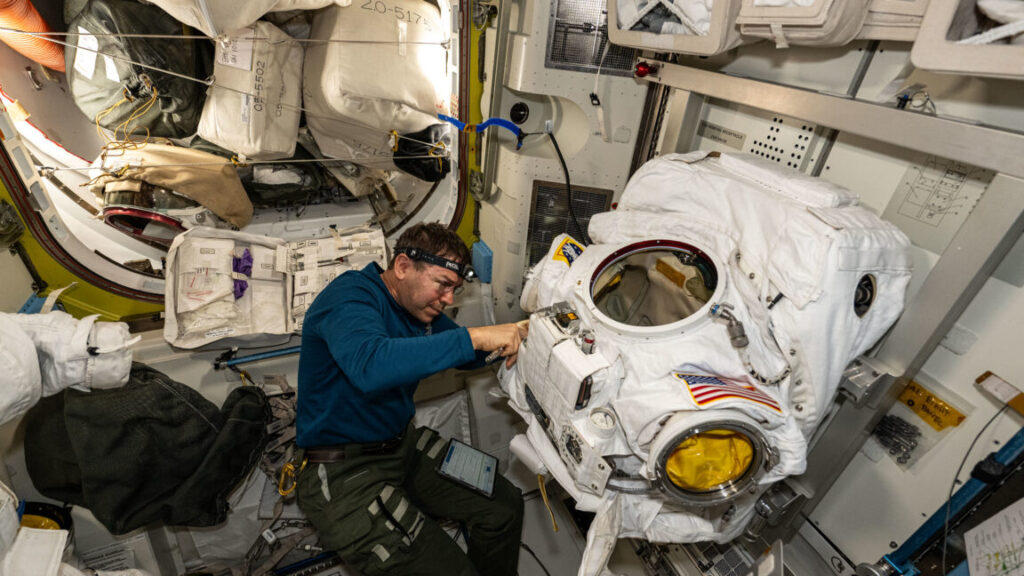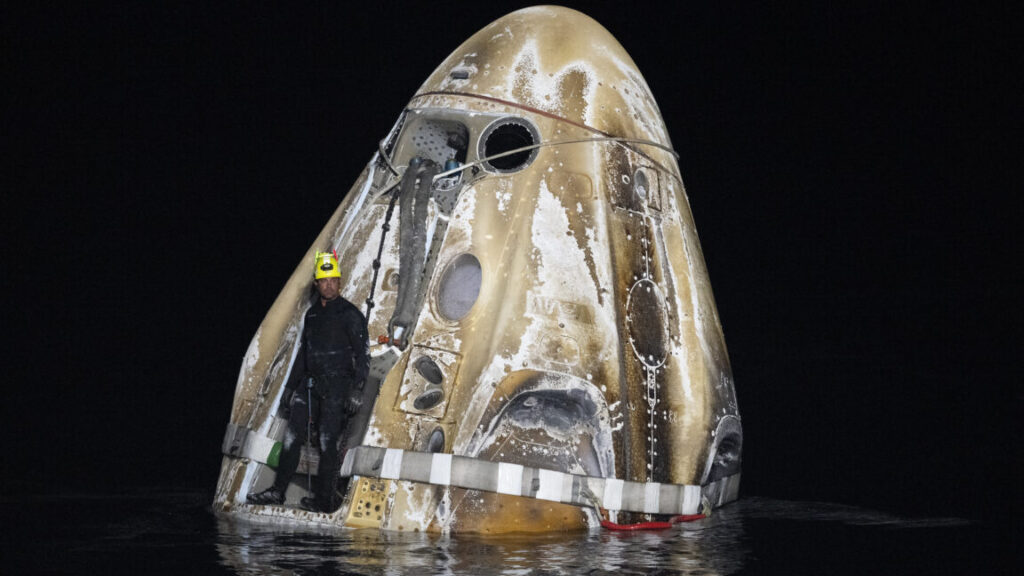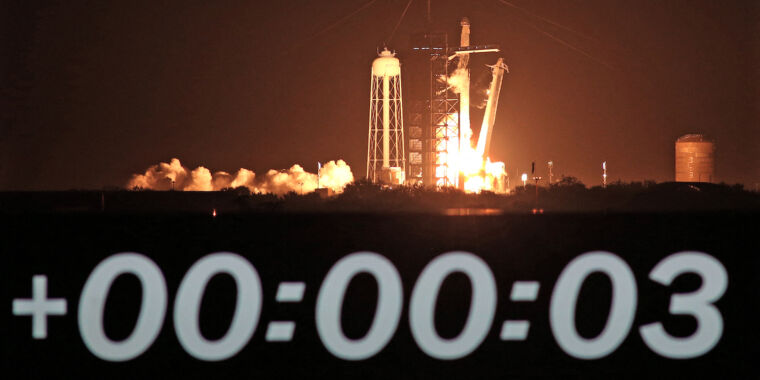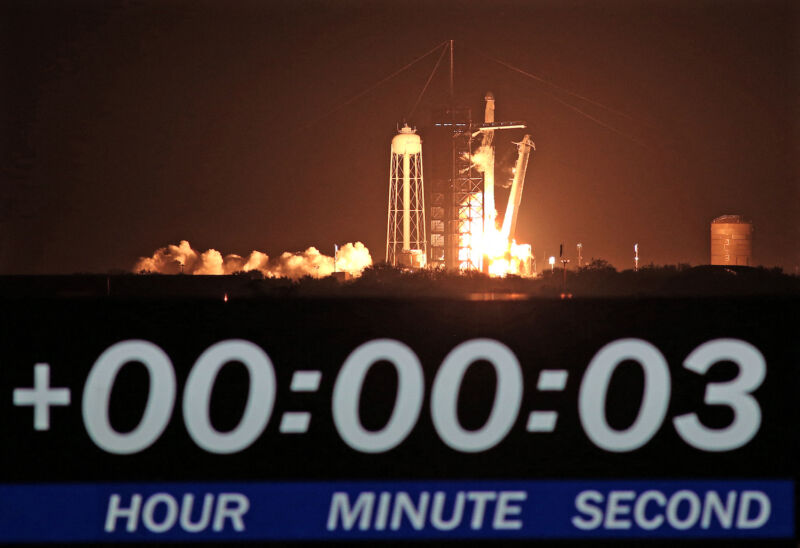There are some things the Crew-8 astronauts aren’t ready to talk about
“I did not say I was uncomfortable talking about it. I said we’re not going to talk about it.”
NASA astronaut Michael Barratt works with a spacesuit inside the Quest airlock of the International Space Station on May 31. Credit: NASA
The astronauts who came home from the International Space Station last month experienced some drama on the high frontier, and some of it accompanied them back to Earth.
In orbit, the astronauts aborted two spacewalks, both under unusual circumstances. Then, on October 25, one of the astronauts was hospitalized due to what NASA called an unspecified “medical issue” after splashdown aboard a SpaceX Crew Dragon capsule that concluded the 235-day mission. After an overnight stay in a hospital in Florida, NASA said the astronaut was released “in good health” and returned to their home base in Houston to resume normal post-flight activities.
The space agency did not identify the astronaut or any details about their condition, citing medical privacy concerns. The three NASA astronauts on the Dragon spacecraft included commander Matthew Dominick, pilot Michael Barratt, and mission specialist Jeanette Epps. Russian cosmonaut Alexander Grebenkin accompanied the three NASA crew members. Russia’s space agency confirmed he was not hospitalized after returning to Earth.
Dominick, Barratt, and Epps answered media questions in a post-flight press conference Friday, but they did not offer more information on the medical issue or say who experienced it. NASA initially sent all four crew members to the hospital in Pensacola, Florida, for evaluation, but Grebenkin and two of the NASA astronauts were quickly released and cleared to return to Houston. One astronaut remained behind until the next day.
“Spaceflight is still something we don’t fully understand,” said Barratt, a medical doctor and flight surgeon. “We’re finding things that we don’t expect sometimes. This was one of those times, and we’re still piecing things together on this, and so to maintain medical privacy and to let our processes go forward in an orderly manner, this is all we’re going to say about that event at this time.”
NASA typically makes astronaut health data available to outside researchers, who regularly publish papers while withholding identifying information about crew members. NASA officials often tout gaining knowledge about the human body’s response to spaceflight as one of the main purposes of the International Space Station. The agency is subject to federal laws, including the Health Insurance Portability and Accountability Act (HIPAA) of 1996, restricting the release of private medical information.
“I did not say I was uncomfortable talking about it,” Barratt said. “I said we’re not going to talk about it. I’m a medical doctor. Space medicine is my passion … and how we adapt, how we experience human spaceflight is something that we all take very seriously.”
Maybe some day
Barratt said NASA will release more information about the astronaut’s post-flight medical issue “in the fullness of time.” This was Barratt’s third trip to space and the first spaceflight for Dominick and Epps.
One of the most famous incidents involving hospitalized astronauts was in 1975, before the passage of the HIPAA medical privacy law, when NASA astronauts Thomas Stafford, Deke Slayton, and Vance Brand stayed at a military hospital in Hawaii nearly two weeks after inhaling toxic propellant fumes that accidentally entered their spacecraft’s internal cabin as it descended under parachutes. They were returning to Earth at the end of the Apollo-Soyuz mission, in which they docked their Apollo command module to a Soviet Soyuz spacecraft in orbit.
NASA’s view—and perhaps the public’s, too—of medical privacy has changed in the nearly 50 years since. On that occasion, NASA disclosed that the astronauts suffered from lung irritation, and officials said Brand briefly passed out from the fumes after splashdown, remaining unconscious until his crewmates fitted an oxygen mask tightly over his face. NASA and the military also made doctors available to answer media questions about their condition.
The medical concern after splashdown last month was not the only part of the Crew-8 mission that remains shrouded in mystery. Dominick and NASA astronaut Tracy Dyson were supposed to go outside the International Space Station for a spacewalk June 13, but NASA called off the excursion, citing a “spacesuit discomfort issue.” NASA replaced Dominick with Barratt and rescheduled the spacewalk for June 24 to retrieve a faulty electronics box and collect microbial samples from the exterior of the space station. But that excursion ended after just 31 minutes, when Dyson reported a water leak in the service and cooling umbilical unit of her spacesuit.
While Barratt discussed the water leak in some detail Friday, Dominick declined to answer a question from Ars regarding the suit discomfort issue. “We’re still reviewing and trying to figure all the details,” he said.
Aging suits
Regarding the water leak, Barratt said he and Dyson noticed her suit had a “spewing umbilical, which was quite dramatic, actually.” The decision to abandon the spacewalk was a “no-brainer,” he said.
“It was not a trivial leak, and we’ve got footage,” Barratt said. “Anybody who was watching NASA TV at the time could see there was basically a snowstorm, a blizzard, spewing from the airlock because we already had the hatch open. So we were seeing flakes of ice in the airlock, and Tracy was seeing a lot of them on her helmet, on her gloves, and whatnot. Dramatic is the right word, to be real honest.”
Dyson, who came back to Earth in September on a Russian Soyuz spacecraft, reconnected the leaking umbilical with her gloves and helmet covered with ice, with restricted vision. “Tracy’s actions were nowhere short of heroic,” Barratt said.
Once the leak stabilized, the astronauts closed the hatch and began repressurizing the airlock.
“Getting the airlock closed was kind of me grabbing her legs and using her as an end effector to lever that thing closed, and she just made it happen,” Barratt said. “So, yeah, there was this drama. Everything worked out fine. Again, normal processes and procedures saved our bacon.”
Barratt said the leak wasn’t caused by any procedural error as the astronauts prepared their suits for the spacewalk.
“It was definitely a hardware issue,” he said. “There was a little poppet valve on the interface that didn’t quite seat, so really, the question became why didn’t that seat? We solved that problem by changing out the whole umbilical.”
By then, NASA’s attention on the space station had turned to other tasks, such as experiments, the arrival of a new cargo ship, and testing of Boeing’s Starliner crew capsule docked at the complex, before it ultimately departed and left its crew behind. The spacewalk wasn’t urgent, so it had to wait. NASA now plans to attempt the spacewalk again as soon as January with a different set of astronauts.
Barratt thinks the spacesuits on the space station are good to go for the next spacewalk. However, the suits are decades old, and their original designs date back more than 40 years, when NASA developed the units for use on the space shuttle. Efforts to develop a replacement suit for use in low-Earth orbit have stalled. In June, Collins Aerospace dropped out of a NASA contract to build new spacesuits for servicing the International Space Station and future orbiting research outposts.
“None of our spacesuits are spring chickens, so we will expect to see some hardware issues with repeated use and not really upgrading,” Barratt said.
There are some things the Crew-8 astronauts aren’t ready to talk about Read More »





